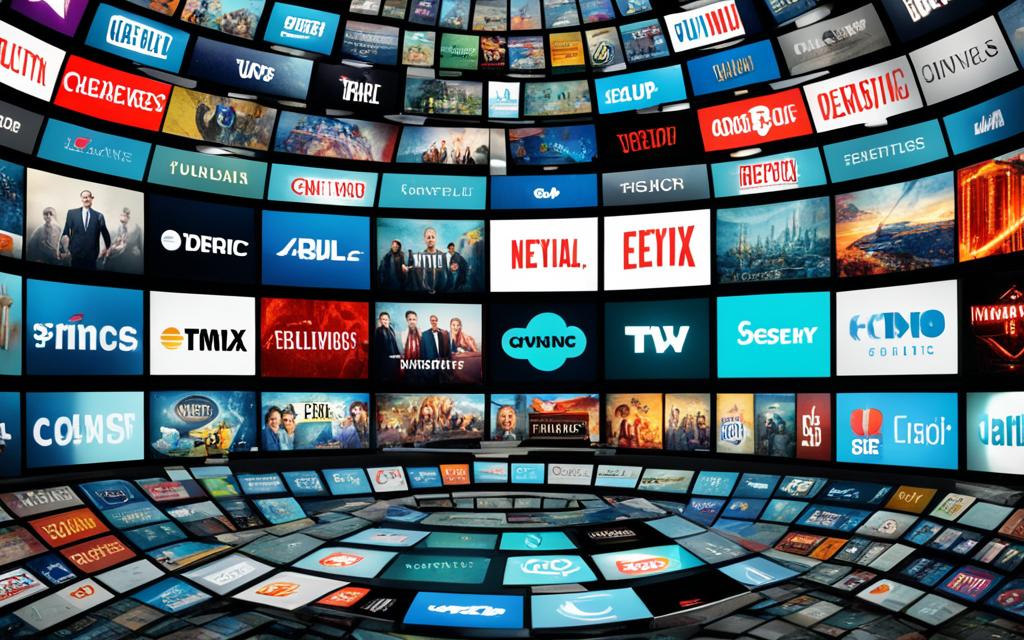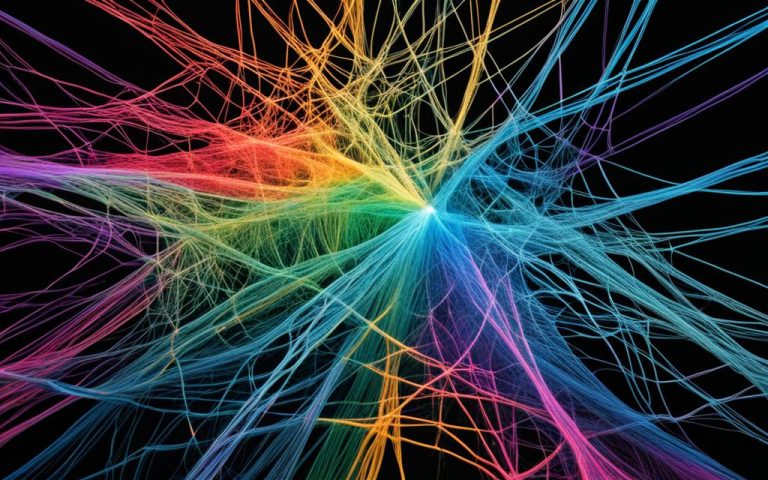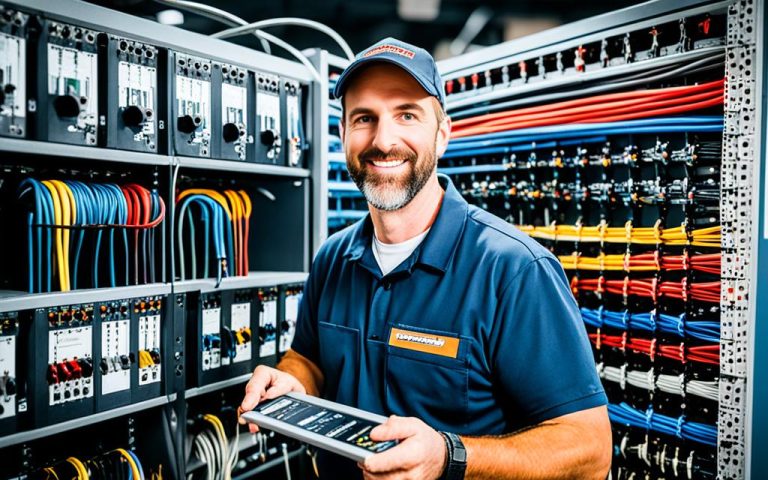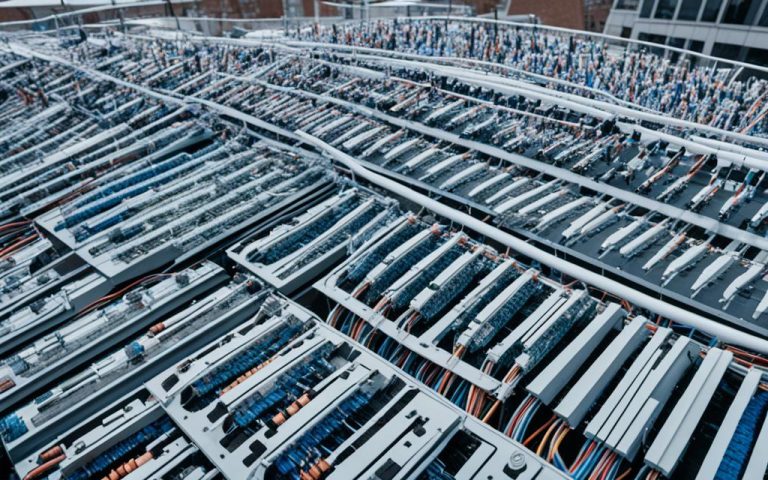Over the past few decades, cable television has undergone a significant transformation in the digital era. With advancements in technology, the way we consume and experience TV programming has evolved, reshaping the industry as we know it.
The switch from analog to digital technology has played a crucial role in this evolution. Digital transmission has brought numerous benefits, including improved picture and sound quality, increased channel capacity, and interactive features.
Moreover, cable TV networks have embraced Internet Protocol Television (IPTV) and streaming services, offering viewers a wide array of channels and access to on-demand content. This has revolutionized the television landscape, providing flexibility and convenience to viewers.
In this article, we will explore the various aspects of the evolution of cable TV networks in the digital era, from the shift from analog to digital technology and the rise of IPTV to the convergence of cable TV and streaming services. We will also delve into the impact of technology on TV consumption habits and discuss the future of television in a rapidly changing digital landscape.
The Shift from Analog to Digital Technology
Cable TV networks have undergone a significant transformation with the shift from analog to digital technology. The transition from analog signals transmitted through coaxial cables to digital signals encoded as binary data has revolutionized the industry, bringing numerous improvements and advancements. This section explores the impact of this shift and the benefits it has brought to cable TV viewers.
Analog TV, which relied on analog signals, had several limitations such as interference, limited channel capacity, and poor reception. These limitations affected the overall viewing experience and left viewers craving for enhanced quality and more options.
The advent of digital technology changed the game for cable TV networks. Digital signals brought a host of benefits, including:
- Improved Picture and Sound Quality: Digital technology enabled cable TV networks to deliver high-definition (HD) programming, resulting in crisp and clear visuals, and enhanced audio quality.
- Increased Channel Capacity: With digital signals, cable TV networks could transmit more channels within the same bandwidth, offering viewers a wider range of programming options.
- Interactive Features: Digital technology introduced interactive features, allowing viewers to engage with content in new and exciting ways. Cable TV networks began offering interactive services and applications, expanding the possibilities of entertainment.
- New Services: The shift to digital technology opened doors to new services such as video-on-demand (VOD), giving viewers the freedom to access their favorite shows and movies at their convenience.
“Digital signals brought improved picture and sound quality, increased channel capacity, and interactive features.”
The shift from analog to digital technology marked a turning point for cable TV networks, enhancing the overall viewing experience and meeting the evolving demands of viewers.
The Rise of Internet Protocol Television (IPTV)
With the advancement of technology, cable TV networks have embraced Internet Protocol Television (IPTV) to deliver television content through broadband internet connections. This innovative approach allows viewers to access a vast array of channels and on-demand content using their TVs, computers, or mobile devices. IPTV has revolutionized the way we consume and interact with TV programming, providing flexibility and convenience that was previously unimaginable.
Unlike traditional cable TV, which relies on physical infrastructure and limited channel capacity, IPTV leverages the power of broadband internet connections to stream television content directly to viewers. This eliminates the need for cable or satellite dishes and enables instant access to a diverse range of channels and on-demand content. Whether it’s watching live sports events, catching up on favorite shows, or exploring a library of movies, IPTV offers an unparalleled viewing experience.
One of the key advantages of IPTV is its ability to deliver high-quality video and audio. With a stable broadband internet connection, viewers can enjoy crystal-clear picture quality and immersive sound, enhancing their overall viewing experience. This is particularly beneficial for streaming live events or watching high-definition content, where every detail matters.
Another significant benefit of IPTV is the flexibility it provides. With cable TV, viewers are bound by predetermined schedules and limited channel options. However, with IPTV, viewers have the freedom to choose what, when, and how they want to watch. They can pause, rewind, and fast-forward through programs, access catch-up TV services to watch previously aired episodes, and even personalize their channel lineups to suit their preferences. This level of control and customization has changed the way we engage with television.
“IPTV has transformed my TV-watching experience. I can now watch my favorite shows on demand, pause and resume whenever I want, and even create personalized playlists. It’s like having a tailor-made TV service just for me.”
IPTV also allows for multi-device access, meaning viewers can watch their favorite shows and movies on their smart TVs, laptops, tablets, or smartphones. This portability and convenience make IPTV a perfect fit for our increasingly mobile and connected lifestyles. Whether you’re at home, commuting, or traveling, you can enjoy your favorite TV content wherever you are, as long as you have an internet connection.
The rise of IPTV has not only transformed how we consume television content but has also opened up new opportunities for content creators and providers. With IPTV, smaller production companies and independent creators can showcase their work to a global audience without the need for traditional broadcast platforms. This has led to a diversification of content, offering viewers a wider range of options and perspectives.
As IPTV continues to evolve, we can expect even more exciting developments in the future. The integration of artificial intelligence and machine learning algorithms will enhance content discovery, providing personalized recommendations based on viewer preferences. Furthermore, advancements in streaming technology will ensure smoother playback and higher-quality video, bringing us closer to a truly immersive viewing experience.
The rise of IPTV has marked a significant shift in the TV industry, empowering viewers and changing the way we engage with television content. Through the use of broadband internet connections, IPTV provides unparalleled access to a vast selection of channels and on-demand content, all customizable to individual preferences. As technology continues to advance, the future of television looks promising, promising more convenience and innovation for viewers around the world.
The Convergence of Cable TV and Streaming Services
Cable TV providers have embraced streaming services, offering subscribers the flexibility to access content through platforms like Netflix, Hulu, and Amazon Prime Video. This convergence of traditional cable TV and streaming services has given rise to a new era of entertainment, where viewers have unprecedented control over what, when, and how they watch their favorite shows. Streaming services have disrupted traditional cable and satellite TV models by emphasizing flexibility and personalization.
The seamless integration of cable TV and streaming services has expanded the range of entertainment options available to viewers. With a cable TV subscription, viewers can access popular streaming platforms like Netflix and Amazon Prime Video directly from their cable package, eliminating the need for additional subscriptions.
This convergence offers several benefits to viewers. It allows them to enjoy the convenience of streaming services while still having access to live TV channels and premium cable networks. Additionally, subscribers can use one platform to access both cable TV channels and on-demand content, simplifying their entertainment experience.
By combining cable TV and streaming services, viewers have the freedom to choose from a vast library of content and customize their viewing preferences. They can watch their favorite shows and movies on-demand, binge-watch entire seasons, and explore a multitude of genres and categories. The convenience of streaming services also enables viewers to watch content on multiple devices, such as smartphones, tablets, and smart TVs.

Furthermore, the convergence of cable TV and streaming services has prompted cable providers to innovate and enhance their offerings to stay competitive in the digital landscape. They now provide features like personalized recommendations, advanced search functionalities, and the ability to bookmark and resume content across different devices. This convergence has revolutionized the entertainment industry, empowering viewers to take control of their TV-watching experience.
The Advantages of Cable TV and Streaming Services Convergence:
- Access to a wide range of cable TV channels and on-demand content
- Flexible viewing options: live TV, on-demand, and binge-watching
- Personalized recommendations and advanced search capabilities
- Multi-device accessibility for convenient viewing
- Simplified entertainment experience with a single platform for cable TV and streaming
A Comparison of Cable TV and Streaming Services
| Aspect | Cable TV | Streaming Services |
|---|---|---|
| Channel Variety | Wide range of live TV channels, including news, sports, and premium networks | Limited live TV channels, focused on on-demand content and original programming |
| Content Availability | Access to cable TV channels, including regional and international programming | Extensive library of movies, TV shows, documentaries, and originals |
| Flexibility | Scheduled programming with set air times | On-demand viewing with the ability to pause, rewind, and fast forward |
| Customization | Choice of different cable TV packages and add-ons | Ability to select specific streaming services and customize subscriptions |
| Cost | Variable pricing depending on the selected cable TV package | Monthly subscription fees for streaming services |
This convergence of cable TV and streaming services has transformed the entertainment landscape, providing viewers with an array of options and control over their TV consumption. By combining the best of cable TV and on-demand streaming, viewers can enjoy a personalized and immersive entertainment experience.
The Impact of Technology on TV Consumption Habits
The advent of technology has had a profound impact on TV consumption habits, transforming the way viewers engage with their favorite shows and movies. The rise of on-demand content and streaming services has revolutionized the television industry, giving viewers unprecedented control over what they watch and when they watch it.
The Rise of On-Demand Content and Binge-Watching
One of the most significant changes in TV consumption habits is the popularity of on-demand content. With platforms like Netflix, Hulu, and Amazon Prime Video offering vast libraries of TV shows and movies, viewers can now access their favorite content at any time. This flexibility has led to the rise of binge-watching, where viewers consume multiple episodes or even entire seasons of a series in a single sitting.
“On-demand content has transformed the way we watch television. Binge-watching has become a cultural phenomenon, allowing viewers to immerse themselves fully in a series.”
Streaming services also provide viewers with the option to pause, rewind, or fast-forward through content. This level of control over the viewing experience has empowered viewers to tailor their TV consumption to their preferences, enhancing their overall entertainment experience.
The Social Aspect of TV Consumption
In addition to on-demand content, social media has played a pivotal role in transforming TV consumption habits. Platforms like Twitter, Facebook, and Instagram have made TV watching a communal and interactive experience. Viewers can engage in real-time discussions about their favorite shows, share their thoughts and reactions, and discover new content through recommendations from friends and influencers.
Social media platforms have become virtual watercoolers where viewers can connect with others who share their interests, creating a sense of community around TV shows. This social aspect of TV consumption has added a new layer of engagement and excitement to the viewing experience.
The Convenience of Streaming Services
Streaming services have revolutionized the way viewers access and consume TV content. With just a few clicks, viewers can stream their favorite shows and movies on a variety of devices, including smart TVs, laptops, tablets, and smartphones. This convenience has made TV consumption more accessible and personalized, catering to the diverse needs and preferences of viewers.
Streaming services also offer personalized recommendations based on viewers’ previous watching habits, making it easier than ever for viewers to discover new content that aligns with their interests. This personalized approach enhances the overall TV-watching experience and ensures that viewers are constantly exposed to content they are likely to enjoy.
| Benefits of Technology on TV Consumption Habits | Challenges of Technology on TV Consumption Habits |
|---|---|
| Convenience and flexibility | Information overload |
| Diverse content options | Lack of shared viewing experience |
| Enhanced viewing experience | Increased screen time |
As technology continues to advance, the future of TV consumption habits is expected to evolve further. With the emergence of new technologies like virtual reality (VR) and augmented reality (AR), viewers can anticipate even more immersive and interactive entertainment experiences. The streaming industry is also likely to expand, offering viewers an even wider range of options and content to explore.

The Future of Television
The future of television promises exciting innovations and advancements that will revolutionize the way we experience and engage with our favorite shows and movies. Technological advancements in display technology, streaming quality, and the integration of cutting-edge technologies like virtual reality (VR) and artificial intelligence (AI) are set to shape the future of television.
One of the key areas of focus in the future of television is display technology. Viewers can expect higher resolutions, faster refresh rates, and enhanced color reproduction, delivering a truly immersive and lifelike viewing experience. Innovations such as OLED and MicroLED displays are already pushing the boundaries of visual quality, and we can anticipate further advancements in the coming years. These advancements will bring images to life with vibrant colors, deep blacks, and incredible detail, making the television viewing experience more captivating than ever before.
Another crucial aspect of the future of television is streaming quality. With the increasing popularity of streaming services, the demand for high-quality streaming content is on the rise. Streaming platforms are constantly investing in infrastructure and technology to improve video compression algorithms and enhance streaming quality. This means viewers can look forward to smoother playback, reduced buffering, and optimized video quality, providing an uninterrupted and enjoyable streaming experience.
Virtual reality (VR) and artificial intelligence (AI) are two technologies that are poised to transform the future of television. VR has the potential to offer viewers an immersive and interactive experience, transporting them into a virtual world where they can be fully immersed in the content. On the other hand, AI-driven technologies will bring personalized recommendations and content curation, ensuring that viewers receive tailored suggestions based on their preferences and viewing habits. These technologies will add a new dimension to the television viewing experience, making it more personalized and engaging.
“The future of television will bring innovations in display technology, improvements in streaming quality, and the adoption of new technologies like virtual reality and artificial intelligence.”
Streaming video services will continue to dominate the future of television. With platforms like Netflix, Amazon Prime Video, and Disney+ offering a vast library of movies and TV shows, viewers can access their favorite content anytime, anywhere. The convenience and flexibility of streaming services have revolutionized the way we consume television, and this trend is expected to continue as more viewers turn to streaming as their primary source of entertainment.
As the future of television unfolds, viewers can expect a transformative and immersive viewing experience. From stunning display technology to seamless streaming, the future of television holds endless possibilities for entertainment enthusiasts.
| Key Advancements | Impact |
|---|---|
| Improved display technology (OLED, MicroLED) | Immersive and lifelike viewing experience |
| Enhanced streaming quality | Smooth playback, reduced buffering, optimized video quality |
| Integration of virtual reality (VR) | Immersive and interactive viewing experience |
| Artificial intelligence (AI) recommendations | Personalized content suggestions based on viewer preferences |
| Growth of streaming video services | Access to a vast library of movies and TV shows |
Television’s Influence on Society
Television has a profound impact on society, playing a significant role in cultural exchange and shaping public opinion. As a powerful medium, television bridges geographical boundaries, allowing people around the world to access and appreciate diverse cultures.
The exchange of cultural content through television programs fosters a sense of interconnectedness among individuals and communities. It enables viewers to gain insights into different traditions, customs, and ways of life, promoting empathy, understanding, and tolerance.
Television also plays a pivotal role in shaping societal norms and values. Through the portrayal of diverse characters and stories, it reflects and sometimes challenges prevailing cultural attitudes, paving the way for social progress and inclusivity.
Furthermore, television holds the power to influence public opinion and awareness. News and informational programming disseminate information and shape public perceptions on critical issues, such as politics, social justice, and environmental concerns. This influence extends to fostering civic engagement, as viewers become more informed and motivated to participate in societal discussions and activities.
By harnessing the potential of television’s influence, society can strive towards a more interconnected and culturally enriched world. It is crucial for content creators, broadcasters, and viewers alike to recognize and appreciate the profound impact that television has on our collective consciousness.
Key Points:
- Television facilitates cultural exchange, allowing access to diverse cultures.
- It shapes societal norms and values, reflecting and challenging cultural attitudes.
- Television influences public opinion and awareness through news and informational programming.
- It fosters civic engagement by shaping public perceptions and encouraging participation.
Conclusion
The digital revolution has brought about a significant transformation in the cable TV industry, revolutionizing the way viewers consume and experience television programming. The shift from analog to digital technology has delivered numerous benefits, including improved picture and sound quality, increased channel capacity, and interactive features.
Furthermore, cable TV providers have embraced Internet Protocol Television (IPTV) and streaming services, meeting the evolving viewer preferences. With a wide array of channels and on-demand content, viewers now have the flexibility to access their favorite shows on various devices, whether it be their television, computer, or mobile device.
As technology continues to advance, we can anticipate further evolution in cable TV networks. Innovations such as improved streaming quality, advancements in display technology, and the integration of virtual reality (VR) and artificial intelligence (AI) will enhance the viewer experience, offering more personalized and immersive entertainment.
In conclusion, the digital revolution and the integration of IPTV and streaming services have shaped the landscape of cable TV. As viewer preferences continue to evolve, cable TV networks will adapt, ensuring that viewers can enjoy a diverse selection of content and a seamless entertainment experience across various devices.
FAQ
How has cable TV evolved in the digital era?
Cable TV networks have undergone significant transformations in the digital era, transitioning from analog to digital technology. This shift has brought improvements in picture and sound quality, increased channel capacity, and the introduction of interactive features.
What are the benefits of the shift from analog to digital technology in cable TV?
The shift from analog to digital technology in cable TV has resulted in improved picture and sound quality, increased channel capacity, and the introduction of interactive features such as video-on-demand (VOD) and high-definition (HD) programming.
What is Internet Protocol Television (IPTV) and how has it revolutionized cable TV?
Internet Protocol Television (IPTV) utilizes broadband internet connections to deliver television content, providing viewers with access to an extensive array of channels and on-demand content. IPTV has revolutionized cable TV by offering flexibility and convenience across a range of devices including TVs, computers, and mobile devices.
How have cable TV and streaming services converged?
Cable TV providers have embraced streaming services, allowing subscribers to access content through platforms like Netflix, Hulu, and Amazon Prime Video. This convergence has given viewers unprecedented control over their viewing experience, with the ability to choose what, when, and how they watch their favorite shows.
How has technology impacted TV consumption habits?
Technology has revolutionized TV consumption habits, providing viewers with on-demand content and streaming services. Binge-watching has become popular, enabling viewers to watch multiple episodes or an entire season of a series in one sitting. Social media has also transformed TV consumption, making it a communal and interactive experience through real-time discussions and content discovery.
What does the future hold for television?
The future of television is expected to bring exciting technological advancements, including innovations in display technology, improvements in streaming quality, and the adoption of new technologies like virtual reality (VR) and artificial intelligence (AI). Viewers can anticipate a more immersive viewing experience with higher resolutions, faster refresh rates, and personalized content recommendations.
How does television influence society?
Television serves as a powerful medium for cultural exchange, allowing people around the world to access and appreciate diverse cultures. It plays a pivotal role in shaping societal norms and values, reflecting and sometimes challenging prevailing cultural attitudes. Television also influences public opinion and awareness, particularly through news and informational programming, shaping public perceptions and fostering civic engagement.
What is the impact of the digital revolution in cable TV on viewer preferences?
The digital revolution in cable TV has brought about changes in viewer preferences. With the introduction of on-demand content, streaming services, and increased control over what they watch, viewers now have more options and flexibility in their TV viewing choices.




















One Comment